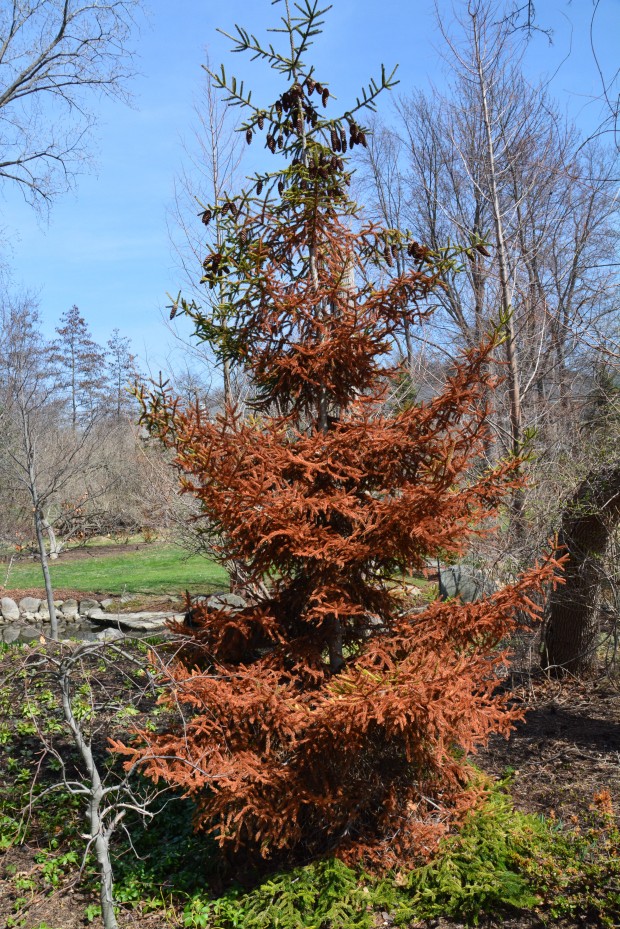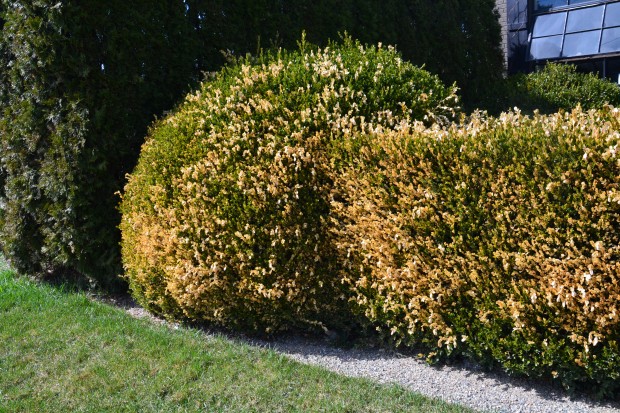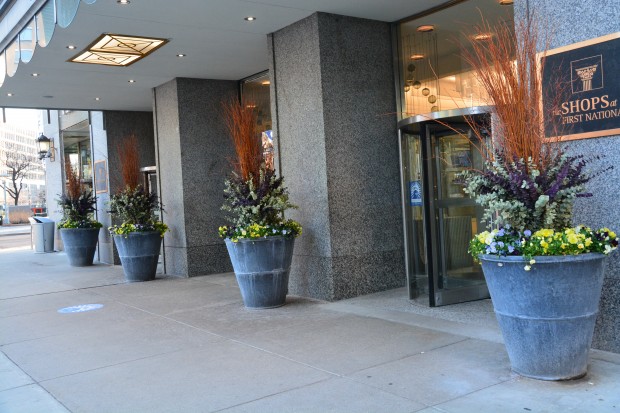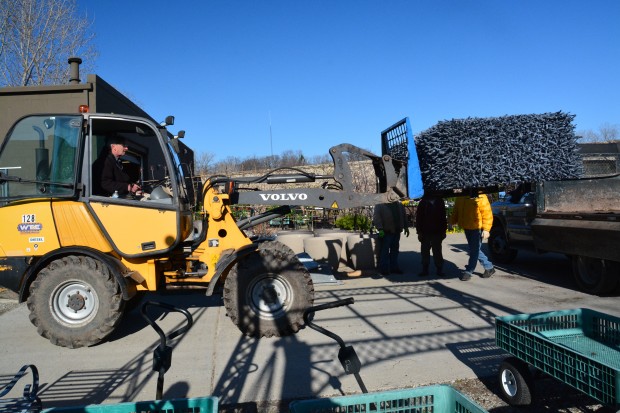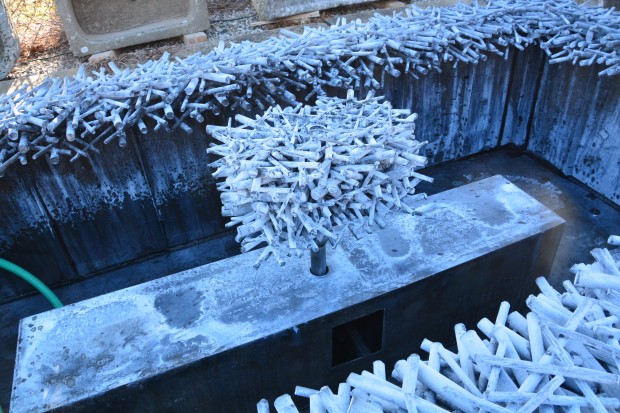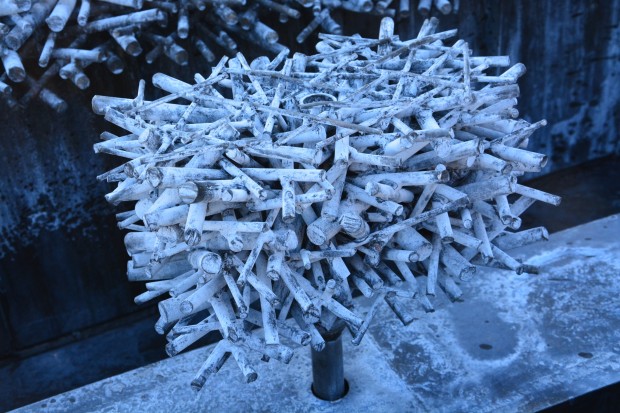 Our spring so far has been cold. As in damp April 42 degree cold. I spent the day outside with my crew today-I am chilled all the way through. Of course I expected a stellar spring, given the extreme length and depth of our winter. Silly, that. Our spring is hung over in the worst possible way from an arctic style winter. Landscapes from house to house are troubled. Only yesterday did I see a forsythia in bloom. Thin bloom, by the way. Today I have a magnolia stellata at home blooming-a month late. The flowers are small, but there are lots of them. This is the good part of the bad and the ugly.
Our spring so far has been cold. As in damp April 42 degree cold. I spent the day outside with my crew today-I am chilled all the way through. Of course I expected a stellar spring, given the extreme length and depth of our winter. Silly, that. Our spring is hung over in the worst possible way from an arctic style winter. Landscapes from house to house are troubled. Only yesterday did I see a forsythia in bloom. Thin bloom, by the way. Today I have a magnolia stellata at home blooming-a month late. The flowers are small, but there are lots of them. This is the good part of the bad and the ugly.
 The residual effect of a winter such as we have had may mean that the spring and early summer may be cold. Gardeners in Michigan are well aware of this. The Great Lakes still are 40% ice covered. Air moving over our very cold lakes means we may have to live with chilly conditions for a while. Maybe quite a while. My reaction? Plant like crazy for spring.
The residual effect of a winter such as we have had may mean that the spring and early summer may be cold. Gardeners in Michigan are well aware of this. The Great Lakes still are 40% ice covered. Air moving over our very cold lakes means we may have to live with chilly conditions for a while. Maybe quite a while. My reaction? Plant like crazy for spring.
 Had I known that this winter would prove to be so relentless and lengthy, I might have planted more spring flowering bulbs. More hellebores. A group of hamamelis. Hindsight is twenty-twenty, yes. Never has some spring color meant so much to these winter weary eyes. We have been planting spring pots non stop since the first week of April, and for good reason. Nature has not seen fit to let go, and move on. I am not inclined to hang back, and do without. Anyone who loves the garden is ready to see something grow and bloom.
Had I known that this winter would prove to be so relentless and lengthy, I might have planted more spring flowering bulbs. More hellebores. A group of hamamelis. Hindsight is twenty-twenty, yes. Never has some spring color meant so much to these winter weary eyes. We have been planting spring pots non stop since the first week of April, and for good reason. Nature has not seen fit to let go, and move on. I am not inclined to hang back, and do without. Anyone who loves the garden is ready to see something grow and bloom.
 I can think of no better year to plant some containers for spring. My guess would be that the reliably warm weather is many weeks away, and that the early part of the summer may stay cool. I have no science whatsoever to back this up, but I see that the transition from one season to another always takes a month or better. A transition from a brutally cold winter to summer indicates a transition that may be protracted. I hate to predict, as predicting the weather is a skill vastly beyond my abilities, but I will say I feel my area may feature residual cool weather.
I can think of no better year to plant some containers for spring. My guess would be that the reliably warm weather is many weeks away, and that the early part of the summer may stay cool. I have no science whatsoever to back this up, but I see that the transition from one season to another always takes a month or better. A transition from a brutally cold winter to summer indicates a transition that may be protracted. I hate to predict, as predicting the weather is a skill vastly beyond my abilities, but I will say I feel my area may feature residual cool weather.
 Lots of plants tolerate, and thrive in cool weather. On the thriving side, cool weather vegetables such as peas, as sweet peas,, pansies, violas, parsley, chard and alyssum. On the tolerant side, osteospermum, rosemary, sagina, lavender, dill, angelina and dusty miller. I would bet there are lots of plants I have missed. One only needs enough cold spring tolerant plants to assemble a palette. And plant.
Lots of plants tolerate, and thrive in cool weather. On the thriving side, cool weather vegetables such as peas, as sweet peas,, pansies, violas, parsley, chard and alyssum. On the tolerant side, osteospermum, rosemary, sagina, lavender, dill, angelina and dusty miller. I would bet there are lots of plants I have missed. One only needs enough cold spring tolerant plants to assemble a palette. And plant.
 I will do whatever it takes to add a big splash of color to a spring planting. This lavender preserved eucalyptus and yellow-green preserved lepto adds a big splash of color to a landscape which is by and large still dormant. Thank heavens for the pansies. That live and vibrant color is strong medicine for anyone who is garden starved.
I will do whatever it takes to add a big splash of color to a spring planting. This lavender preserved eucalyptus and yellow-green preserved lepto adds a big splash of color to a landscape which is by and large still dormant. Thank heavens for the pansies. That live and vibrant color is strong medicine for anyone who is garden starved.
 I did plant the window boxes at the shop for spring. This one features sweet peas Rob bought on a plant buying trip out east this past week. The trailing violas and phlox intensia will grow. The centerpiece of this window box is an arrangement made from preserved eucalyptus, hakea, lepto, and curly pussy willow. This centerpiece of preserved and fresh materials will make a generous statement about spring until these plants take hold.
I did plant the window boxes at the shop for spring. This one features sweet peas Rob bought on a plant buying trip out east this past week. The trailing violas and phlox intensia will grow. The centerpiece of this window box is an arrangement made from preserved eucalyptus, hakea, lepto, and curly pussy willow. This centerpiece of preserved and fresh materials will make a generous statement about spring until these plants take hold.
 Spring containers in my zone are plant challenged. Cold weather means the cold tolerant plants may take a while to take hold, and represent. The alyssum and creeping jenny will soften the edges of these urns. By early May, these plants will be thriving. They may still be thriving, come the first of July. In the meantime, the centerpieces for these urns will provide both color and scale. Containers do a great job of providing a little drama ahead of a garden just waking up.
Spring containers in my zone are plant challenged. Cold weather means the cold tolerant plants may take a while to take hold, and represent. The alyssum and creeping jenny will soften the edges of these urns. By early May, these plants will be thriving. They may still be thriving, come the first of July. In the meantime, the centerpieces for these urns will provide both color and scale. Containers do a great job of providing a little drama ahead of a garden just waking up.
 Pansies,, alyssum and creeping jenny are sure harbingers of spring. But they have a modest profile, like many cold tolerant spring plants. No need to ask them to make a splash. Making a splash of a punch of spring color is entirely in your hands.
Pansies,, alyssum and creeping jenny are sure harbingers of spring. But they have a modest profile, like many cold tolerant spring plants. No need to ask them to make a splash. Making a splash of a punch of spring color is entirely in your hands.
 Any material you have at your disposal can dress a spring container planting. Cut forsythia branches, or pussy willow in a spring container-beautiful. You cut branches might root in the pot. Green leaves breaking from branches may be all you need to move on from the winter.
Any material you have at your disposal can dress a spring container planting. Cut forsythia branches, or pussy willow in a spring container-beautiful. You cut branches might root in the pot. Green leaves breaking from branches may be all you need to move on from the winter.
 Every gardener celebrates the spring differently. Every spring is different. My landscape is on a schedule all its own. Biut when I am ready for spring, I do not dog my landscape to come to. What good would that do? The plants in my landscape will make their program known over the next four weeks. In that meantime, I plant spring pots. Should your garden still be really sleepy, a container planted up for spring could make for some sunshine. Try it.
Every gardener celebrates the spring differently. Every spring is different. My landscape is on a schedule all its own. Biut when I am ready for spring, I do not dog my landscape to come to. What good would that do? The plants in my landscape will make their program known over the next four weeks. In that meantime, I plant spring pots. Should your garden still be really sleepy, a container planted up for spring could make for some sunshine. Try it.

